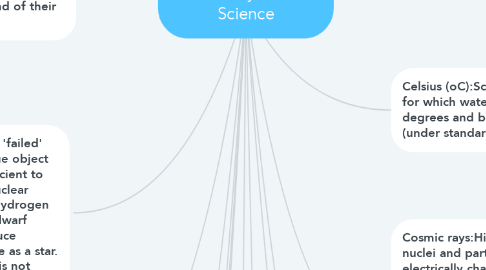Vocabulary web on Science
by JJ EL FUMIGAVION

1. Asteroid belt:Region between the orbits of Mars and Jupiter which is populated by billions of asteroids.
2. Black hole:An object with so much mass concentrated in it, and therefore such a strong gravitational pull that nothing, not even light can escape from it. One way in which black holes are believed to form is when massive stars collapse at the end of their lives.
3. Brown dwarf:A kind of 'failed' star: a small and opaque object whose mass is not sufficient to start, in its core, the nuclear reaction to transform hydrogen into helium. A brown dwarf cannot therefore produce enough energy to shine as a star. A brown dwarf's mass is not more than 0.08 solar masses.
4. Coma: Cloud of gas and dust surrounding a comet nucleus. Caused by vapourisation of the nucleus and emission of jets containing gas and dust. It grows in size as the comet approaches the Sun and may be up to one million kilometres across soon after the comet reaches perihelion.
5. Crater:Basin-shaped depression in the surface of a planet or moon. May be caused by a comet or asteroid impact, or by a volcanic eruption. Usually circular as seen from above, impact craters often have a raised rim formed from material (ejecta) thrown out by the collision. Larger impact craters have central mountain peaks. Volcanic craters may contain lava which is supplied from subsurface magma. They are surrounded by material produced during previous volcanic eruptions.
6. Energy:The capacity of a body or system to do work. In the metric measurement system, the unit of energy is the Joule, which is the work produced by a force of 1 Newton moving over a distance of 1 metre.
7. Electron:A fundamental physical particle with negative charge. A component of atoms.
8. Galaxy:The structure formed by as assembly of thousands of millions of stars together with gas and dust. Our Galaxy, the Milky Way, is a spiral galaxy. Galaxies may be described as elliptical, irregular or spiral. Our Galaxy is just one among many millions.
9. Gamma ray: The most powerful form of electromagnetic radiation. A typical gamma ray is a photon with an energy greater than 100 keV.
10. Aeronomy:The study of the atmosphere of a planet, with particular attention to the composition, properties and motion of atmosphere constituents.
11. Astronomy:Study of the space beyond the Earth and of its contents.
12. Celsius (oC):Scale of temperature for which water freezes at 0 degrees and boils at 100 degrees (under standard conditions).
13. Cosmic rays:Highly energetic nuclei and particles, generally electrically charged, with energies ranging from 100 million eV to 10 million billion eV. Part of this radiation comes from the Sun, interstellar space, and intergalactic space. When a cosmic ray collides with our atmosphere a shower of secondary particles is created in the upper atmosphere. This air shower triggers a cascade of particle reactions and interactions which propagate to the ground
14. Cryostat:Container used to isolate thermally a fluid from its environment and maintain it at low temperatures.
15. Ethane:A colorless and odorless gas that belongs to the alkane series of the hydrocarbons.
16. Electronvolt (eV):Unit of energy defined as the energy acquired by an electron in falling through a potential difference of one volt. Electronvolts are used as a measure of the energy of cosmic rays and high-energy photons. For example, X-rays can have energies of 1000 eV (1 keV) or more.


